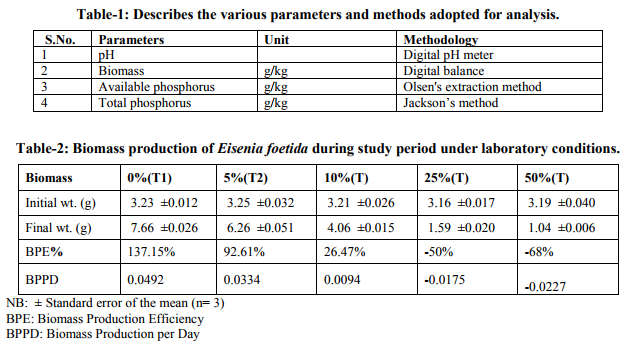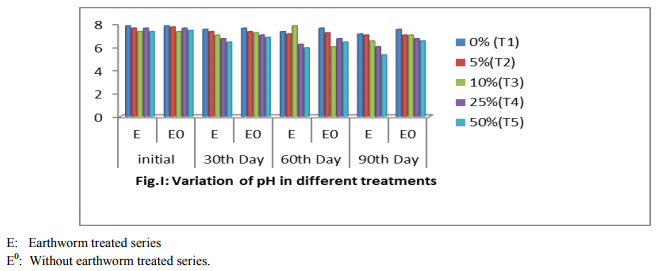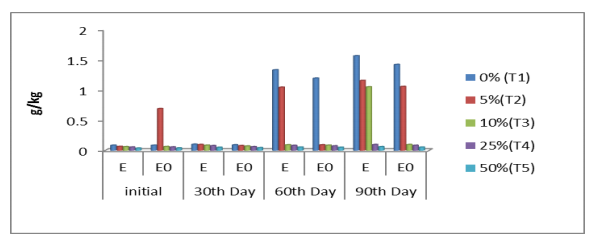IJCRR - 3(9), September, 2011
Pages: 186-192
Print Article
Download XML Download PDF
INCREASING PHOSPHORUS AVAILABILITY FROM FLY ASH THROUGH VERMICOMPOSTING
EMPLOYING EISENIA FOETIDA
Author: Manjari Barsainya, Assadullah Sheikh, A.K.Giri
Category: General Sciences
Abstract:The increasing environmental problems are created by large-scale production of fly ash (FA), attention
is now been paid to the recycling of FA as a good source of nutrients. An important component of
recycling effort is using FA to improve low fertility soils. The study explored the possibility of increasing
phosphorus availability in FA through vermicomposting. Present investigation showed that pH of the
treated and controlled series was decreased with increase in FA concentrations and the biomass
production of the earthworm was increased in the progression of 0% > 5% > 10% > 25% > 50%. The
different combinations of FA and cattle dung (CD) showed that phosphorus availability in FA due to
vermicompost was significantly increased in the 5%, 10% followed by 25% and 50% combinations. The
concentration of nutrients was found to increase in the earthworm treated series of cattle dung and FA
combinations. The increase in available phosphorus may be attributed to direct action of worm gut
enzymes and indirectly by stimulation of micro flora.
Keywords: Fly ash, environmental problems, cattle dung, vermicomposting, Eisenia foetida, biomass.
Full Text:
INTRODUCTION
Fly ash a finely divided solid residue carried out in air, regarded as amorphous ferroaluminosilicate minerals, containing the naturally available elements i.e. similar to that of soil except humus and nitrogen (Wong and Wong, 1986). Combustion of coal in thermal power stations produces a variety of residues fly ash, bottom ash, flue gas desulphurization waste and fluidized bed boiler waste and coal gasification ash and creates various environmental problems such as air, water and soil pollution. Over 225 million tonnes of coal is produced annually in India and over 100 thermal power stations generate more than 110 million tonnes of fly ash every year (Jamwal, 2003) which is expected to double within the next 5-6 years. Annual production of fly ash is generated from thermal power plants during combustion of coal is around 90 million tons and is likely to increase to 140 million tons by 2020 ( Kalra et al., 1997) Fly ash is a serious type of air pollution since it remains air born for a long period of time and causes health hazard. Fly ash interferes with the photosynthesis of plants and thus disturbs the food chain. The magnitude of the problem is evident from the fact that fly ash generated during 2000-2001 was about 150 million tones in India. To prevent fly ash from being air born, the dumping ground needs to be kept wet all time. Thermal power plants in India are reportedly spending seven billion rupees annually on this activity. The major problem is handling and disposal of fly ash. Disposal of fly ash has been increasingly expensive since the landfill space is limited. In view of the environmental problems generated by large scale production of fly ash, more attention is being paid on recycling of fly ash as a good source of nutrients (Gupta et al., 2005). The major problem faced by the coal/lignite thermal power stations all over the world is the handling and disposal of ash. Several workers have tried mixtures of fly ash with organic waste. Mixed applications, fly ash and organic compost on soil and availability and uptake of elements by various plant species was studied (Menon, 1993). Presently, the disposal of such huge amounts of fly ash is done either by dry or wet methods and has become a serious environmental quandary. All methods ultimately lead to the deterioration of the soil and environment problems (Jala and Goyal, 2006). On the other hand fly ash has been also reported for various uses, raw material in building making and in agricultural land reclamation, quarry restoration (Kriesel, et al., 1994). A vast potential for use in agronomy as an amendment, but such use is only accounted for 38% of the fly ash produced by electric power facilities each year (Stevens and Dunn, 2004). However little information is available on the use of fly ash as amendment to agriculture lands for crop production. In recent years, there has been growing interest in using fly ash for crop production, especially for reclamation of wastelands (Adriano et al., 1980; McMarty et al., 1994; Schutter and Fuhrman,1999). Fly ash contains both macro and micro nutrients which can sustain plant growth (Negi and Meenakshi, 1991). It contains several nutrients including P, S, Ca, Fe, Cu, Zn and Mn which are beneficial for plant growth, as well as toxic heavy metals such as, Hg, Cr, Pb, Ni, As, Se etc (Dalmau, et al., 1990). Sustainable use of fly ash to treat agricultural soils tends to conjure concern over long term effects on dynamics and functions of soil biota such as earth worms on which there is least information available. Earthworms may also enhance the fertility of soil treated with coal fly ash by increasing solublization of mineral nutrients such as phosphorus and potassium in the ash (Bhattacharya, et al., 2001). Vermicomposting is one of the recycling technologies, which improves the quality of products. It involves using earthworms to increase the microbial population in vermicasts and help to produce high quality compost from different organic wastes in a lesser period of time (Edwards and Lofty., 1972). With this backdrop present study has been undertaken to work out on the increasing phosphorus availability from fly ash employing earthworms (Eisenia foetida) to know the efficiency of said worm to convert the fly ash into vermicompost and to determine the phosphorus bioavailability and phosphorus solubility in fly ash by using cattle dung as the source of energy through an adoption of vermicomposting technology.
MATERIALS AND METHODS
The study was performed in the laboratory in plastic containers (2-L volume), which were inert in nature. The parameters and methodology adopted are given in Table-1. Triplicate of five combinations of fly ash (FA) and cattle dung (CD) and cattle dung alone as 0%(T1), 5% (T2), 10% (T3), 25%(T4) and 50%(T5) fly ash were used with a total weight of 1 kg material (sample size) in each pot and a set of control in each combination was also maintained without the earthworms. Seven days old, cattle dung was collected from dairy farm, Shivaji Nagar, Jhansi.
The moisture content of the cattle dung was recorded as 66.7%. Each of the experimental treatments were replicated thrice and incubated with and without epigeic earthworm 5 worms kg-1 material. The Eisenia foetida worms were brought from Hisar University, Haryana and unweathered fly ash was obtained from Parichha thermal power plant, Jhansi, India. The materials under each treatment were incubated under moist laboratory conditions for 90 days (February – April 2010) with temperature range of 21.4 to 32.6°C. Samples were drawn periodically at 30 days intervals from each of the combination and were analyzed for pH, biomass, available phosphorus and total phosphorus. In each sample 60-66% moisture was maintained for vermicomposting. Contributions of FA to availability of phosphorus under different treatments were determined by calculating the contribution of CD to availability of phosphorus from the CD treatment and subtracting the respective amount from the different FA + CD contributions. The values were expressed in g/kg. The preparations of different mixtures (CD and FA) were performed as following.
1. Pure cattle dung =1000gm CD = 0% Flyash
2. Cattle dung + Fly ash(950gm CD + 50gm FA)= 5% Flyash
3. Cattle dung + Fly ash(900gm CD +100gm FA)= 10% Flyash
4. Cattle dung + Fly ash(750gm CD +250gm FA)= 25% Flyash
5. Cattle dung + Fly ash(500gm CD +500gm FA)= 50% Flyash
RESULTS AND DISCUSSION
Changes in pH, biomass, available phosphorus and total phosphorus in different combinations of fly ash are presented and discussed as follows. The results depicted that the earthworms play an important role in processing fly ash into organic manure. The earthworm‘s activity accelerated the decomposition of the fly ash and stablizes the waste. The pH of the compost samples in the earthworm treated series (E) ranged from 5.3- 7.8 while as in case of controlled series (E 0 ) it ranged from 6.4-7.8 as given in Fig.-1. The lower pH in vermicompost may be due to the production of CO2 and organic acids by microbial activity during process of bioconversion of organic matter present in the feed (Haimi and Hutha, 1986, Albanell et al., 1988). In all treatments, earthworm reduced the pH value, which is in accordance with (Atiyeh et al., 2000 and Ndegwa et al., 2000). It was observed that in absence of earthworms, the pH also decrease with increase in length of composting. The slight decrease of pH value in all treatments without worms in comparison to combinations with earthworms refers to less microbial activity than in presence of worms. Biomass of earthworms in different treatments at the time of inoculation ranged from 3.16-3.25 g/kg (fresh weight) whereas after 90 days of composting, earthworm biomass production was found to vary in different treatments from 1.04- 7.66 g/kg. The highest earthworm biomass production was recorded of 137.15% in 0%(T1) followed by 92.61% in 5%(T2) and minimum production 26.47% in 10% (T3) as given in Table-2. Interestingly, in treatments 25%(T4) and 50%(T5) concentrations, negative growth of earthworm production was observed, which may be due to the toxicity of fly ash on earthworms (Tripathi and Bhardwaj, 2003). From biomass production of earthworms it is was observed that vermicompost of fly ash amended cattle dung may be suitable at 5% fly ash and permissible up International Journal of Current Research and Review www.ijcrr.com Vol. 03 issue 09 September 2011 189 to 10%. Addition of cattle dung with fly ash had a positive impact on biomass gain, was observed in the present investigation. Evidently cent percent cattle dung showed maximum earthworm biomass gain (0.0492 g/day) with minimum production at 10% FA (0.0094 g/day) as in accordance with Hartenstien et al., (1979) that less than 10% FA is not supporting biomass production as revealed in the present study. However, in 25% and 50% FA treatment showed negative biomass production. Normally phosphorus is found in unavailable forms like calcium phosphate or potassium phosphate. The present study revealed that earthworms have ability to convert insoluble phosphorus in soluble forms. The increase in total phosphorus content after 90 days of composting may be attributed to enhance mineralization process. Vermicompost proved to be the efficient technology for providing better phosphorus nutrition from organic and inorganic wastes. The total phosphorus content in all the treatments was observed to increase after three months of composting. The highest and lowest content of total phosphorus with earthworm treated series (E) before incubation was recorded as 0.70 g/kg in 0% (T1) and 0.67 g/kg in 50%(T5) however similar with that of without earthworm treated series (E0 ). While maximum and minimum content of total phosphorus in earthworm treated series (E) was observed as 1.21 g/kg in 5%(T2) and 1.02 g/kg in 0% (T1) and in case of without earthworm series (E0 ) was observed as 1.13 g/kg in 0% (T1) and 0.98 g/kg in 50%(T5) on 90th day of incubation respectively. This observation may be referred to less mineralization activity in absence of earthworms than presence of earthworms in the treatments. The phosphorus content of all the treatments showed an increasing concentration with increasing period of composting which may be due to the multiplication of the phosphate solublizing microbes in the casts. The total phosphorus content in the present investigation is in accordance with findings of Suthar and Singh (2008). The minimum and maximum content of available phosphorus with earthworm treated series (E) before incubation was recorded as 0.039 g/kg in 50% (T5) and 0.086 g/kg in 0%(T1) however, same as in case of without earthworm series (E0 ). Whereas highest and lowest content of available phosphorus was observed as 1.56 g/kg in 0%(T1) and 0.06 g/kg in 50% (T5) but in case of without earthworm series (E0 ) it was observed as1.418 g/kg in 0% (T1) and 0.054 g/kg in 50%(T5) on 90th day respectively as shown in Figure.-3. It was interesting to observe that adopting vermicomposting technology through the use of earthworms helped to increase the available phosphorus content. Improvement in the amount of extractable phosphorus during vermicomposting and also in absence of earthworm similar findings was observed by Ghosh et al., (1999). They reported that vermicomposting can be an efficient technology for the transformation of unavailable form of phosphorus to easily available forms for plants. It is well established that the release of phosphorus in available form is partly by earthworm gut phosphatase enzymes (Le Bayon et al., 2006) and further release of this may be phosphorus solubilizing microorganisms in casts (Vinotha et al., 2000). Organic materials pass through the gut of earthworms then some of the phosphorus being converted to such forms that are available to plants. The increase in available phosphorus was attributed to direct action of worm gut enzymes and indirectly by stimulation of micro flora. The increasing effect of vermicomposting may be due rich microbial populations in the earthworms gut (Edwards and Lofty, 1972) which may have played the International Journal of Current Research and Review www.ijcrr.com Vol. 03 issue 09 September 2011 190 significant role in the solublizing phosphorus from unavailable forms.
CONCLUSION
Based on present study, it may be concluded that the rate of mineralization could be decreased due to the increasing concentration of fly ash. The higher concentration of fly ash may affect the population of earthworms and microbes. It is also clear that the use of Eisenia foetida, increases phosphorus availability seems to be feasible technology and 5% fly ash combination can be used for sustainable vermicomposting, without showing any toxicity on earthworms. The concentration of nutrients was found to increase in the earthworm treated series of cattle dung and fly ash combinations. The increase in available phosphorus was attributed to direct action of worm gut enzymes and indirectly by stimulation of microorganisms that is available to plants.
ACKNOWLEDGEMENT
The authors are thankful to Head, Institute of Environment and Development Studies, Bundelkhand University, Jhansi, for providing the laboratory facilities for the work undertaken.




Figure-3: Available phosphorus availability in different combinations of fly ash and cattle dung with (E) and without (E0 ) earthworm after 30, 60 and 90 days of incubation
References:
1. Adriano,D.C.,Page, A.L., Elseewi,A.A., Chang, A.C. and Straughan, I . 1980. Utilization and disposal of fly ash and other coal residues in terrestrial ecosystemsA review. J. Environ.Qual. 9: 333-334.
2. Bhattacharya,S.S. and Chattopadhyay, G.N. 2001. Vermicomposting as a tool for increasing availability of nutrients in fly ash, agriculture application of fly ash. Proc. II Nat. Sem, on use of fly ash in agriculture, Annamaliya Univer- sity, Annamaliyanagar, pp: 128-132.
3. Dalmau, J.I., Garau, M.A.and Felipo, M.T. 1990. Laboratory prediction of soluble compounds before soil recycling of wastes . Intr. J. Anal. Chem., 39 (2): 141-146.
4. Edwards, C.A.and Lofty, J.R. 1972. Biology of earthworm‘s Chapman and Hall, London. 5. Gupta, S.K., Tiwari, A. and Srivastava, R. and Murty, R.C. 2005. Potential for Eisena fetida for sustainable and efficient vermicomposting of fly ash.Water Air and Soil Pollut. 163: 293-302.
6. Haimi, J., Hutha, V., 1986. Capacity of various organic residues to support adequate earthworm biomass in vermicomposting. Biol. Fertil. Soil 2: 23-27.
7. Hartenstien,R., Neuhauser, E.F. and Kaplan, D. 1979. Reoroductive potential of earthworm Eisenia fetida. Oecologia 43: 329-340
8. Jackson, M.L. 1975. Soil Chemical Analysis. Practice Hall of India, New Delhi 9. Jala, S., Goyal, D., 2006. Fly ash as a soil ameliorant for improving crop Production-a review. Biore- sour . Technol., 97(9):1136- 47
10. Jamwal, N. 2003. Is it all grey? Down to earth, June 30, 38-41.
11. Kriesel,W., Mcintosh,C.S. and Miller, W.P. 1994. The potential for beneficial reuse of sewage sludge and coal combustion byproducts. J. Environ. Mgt.: 97: 177-90
12. Kalra, N., Harit, R.C., Sharma, S.K., 2000. Effect of fly ash incorporation on soil properties of texturally variant soils. Bioresour. Technol. 75 (1): 91-93.
13. Le Bayon, R.C.,Binet, F. 2006. Earthworms change the distribution and availability of phosphorus in organic substrates. Soil. Biol. Biochem. 38: 235-246
14. McCarty, G.W.R., Sidharmappa, R. J., Wright, E.E. and Gao, G. 1994. Evaluation of coal combustion by-products as soil liming mate- rials: their influence on soil pH and enzyme activities. Biol. Fertil. Soils, 17:147-172 International Journal of Current Research and Review www.ijcrr.com Vol. 03 issue 09 September 2011 191
15. Menon, M.P. 1993. Elements in coal and coal ash residues and their agricultural potential for crops. Trace elements in coal and coal combustion residues, Lewis Publishers, Florida USA, pp: 259-285.
16. Ndegwa, P.M., Thompson, S.A, Das, K.C, 2000. Effects of stocking density and feeding rate on vermicomposting of biosolids. Biores. Technol .71: 5-12.
17. Negi, B.S, and Meenakshi, V.1991. Characterization of coal fly ash from thermal power plants in India.Environment of coal utilization .In:Sahu, K.C.(Ed.), International Conference IIT Bombay, pp : 143-152.
18. Olsen, S.R., Cole, C.V., Watanabe, F.S. and Dean, L.A. 1954. Estimation of available Phosphoprus in soils by extraction with sodium bicarbonate. Circular US Department of Agriculture. pp: 939
19. Schutter, M.E., Fuhrmann, J.J., 2001. Soil microbial community responses to fly ash amendment as revealed by analyses of whole soils and bacterial isolates. Soil Biol. Biochem. 33: 1947-1958.
20. Suthar, S. 2008. Bioremidiation of aerobically treated distillery sludge mixed with cow dung by using an epigeic earthworm, Eisenia fetida. Environ. 28: 76- 84.
21. Tripathi, D and Bhardwaj, P. 2003. Comparative studies on biomass production, life cycles and com- posting efficiency of Eisenia fetida and Lampito mauritii. Bioresource Technology. 92: 275-283.
22. Vinotha, S.P., Parthasarathi, K., Ranganathan, L.S., 2000. Enhanced phosphatase activity in earthworm casts is more of microbial origin. Curr. Sci. 79: 1158-1159
23. Wong, M.H., Wong, J.W.C., 1986. Effects of fly ash on soil microbial activity. Environ. Pollut. Ser. 40: 127-144..
|






 This work is licensed under a Creative Commons Attribution-NonCommercial 4.0 International License
This work is licensed under a Creative Commons Attribution-NonCommercial 4.0 International License